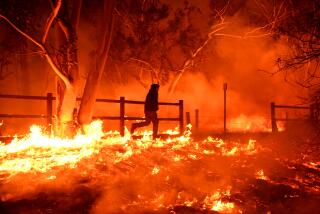‘Worst Case’ Scenario Used in Safety Study on Ammonia : Safety: Edison report describes lethal cloud spreading inland, but says such a leak is highly unlikely. Several Redondo Beach officials are not yet convinced.
- Share via
A major earthquake causes a 10,200-gallon spill of anhydrous ammonia at Southern California Edison’s seaside power station in Redondo Beach. Within 15 minutes, lethal concentrations of ammonia vapors have moved more than half a mile inland in a low-floating chemical cloud.
According to a study filed by Edison, this is the most serious accident that could result from storage of anhydrous ammonia at its Harbor Drive plant. But the company, which plans to use the chemical as part of a new air-pollution control system, also says such an accident is highly unlikely.
Edison described the worst-case scenario in a state-mandated safety plan for the project filed Tuesday with the city of Redondo Beach. Although city leaders fear the ammonia could pose an unacceptable risk to residents, Edison says steps outlined in its safety plan will prevent problems.
“The probability of a tank failing is like one in 10,000 years,” Edison official Larry Johnson, the manager of the anhydrous ammonia project, said Wednesday. “Your probability of having a fatal automobile accident is 100 to 200 times higher.”
It remains to be seen whether Edison’s arguments convince Redondo Beach leaders, who have won a promise from regional air-quality officials to study the ammonia project’s potential environmental effects on the city before approving it.
City officials said Wednesday they have not yet reviewed Edison’s safety plan, which was submitted Tuesday night. But several expressed doubt that it would be enough to ease their fears.
“The problem is that the Edison plant is an outdated use in our community,” said City Councilwoman Barbara Doerr. “It should be farther away from densely populated areas. When you add to that additional dangers from anhydrous ammonia, that makes us very concerned.”
Edison plans to store anhydrous ammonia in two 12,000-gallon tanks as part of a demonstration system designed to remove nitrogen oxide pollutants from flue gases in one of the plant’s four operating boilers. The effort is intended to help the utility meet tightened regional air-quality standards. If successful, the system will be used in other Edison plants to meet new, stricter air-pollution requirements.
In its safety plan, called a Risk Management and Prevention Program, Edison says the worst-case accident would occur if a major earthquake caused a valve on one of the tanks to break, releasing 10,200 gallons of ammonia. Edison officials said the figure represents the contents of one of the tanks, explaining that such tanks are never filled to capacity.
Pushed by the prevailing sea breeze, lethal vapor concentrations in the ground-hugging ammonia cloud would cover parts of the city. It would be 0.7 miles east within 15 minutes. Within a half-hour, the cloud would disperse slightly, and the lethal concentrations would be present 0.4 miles east of the plant.
Meanwhile, detectable levels of ammonia on the leading edge of the cloud would reach 1.5 miles inland within 15 minutes of the accident and three miles east within a half-hour.
If such a disaster were to occur, the chemical would pass through dense commercial and residential areas. According to the safety study, there are 52 schools, 45 day-care facilities, two hospitals and nine long-term care facilities within three miles of the Edison plant. No estimates of fatalities were included in the report.
Asked why the worst-case scenario contemplated the rupture of only one of the two anhydrous ammonia tanks, Johnson, the manager of the Edison project, asserted, “That is just about the worst case you can get.”
In its study, Edison also lists safety measures it would undertake to prevent or control accidents. Among them: tank relief valves to ensure pressure build-ups do not occur, an 18-inch-high wall around the tanks to contain spills and slow evaporation, alarms to warn of overheating, overfilling and leaks, and classes for personnel who work with the ammonia.
The safety report did not address use of a less concentrated form of ammonia, a possibility that the South Coast Air Quality Management District has pledged to look into in its local impact study of the Edison project.
But Edison officials assert that even the more powerful, anhydrous ammonia can be handled safely at their plant. The chemical, they point out, is used widely--albeit on a smaller scale--in many commercial refrigeration systems.
Redondo Beach leaders, however, still have their doubts. Said Mayor Brad Parton on Wednesday: “What if we do have an earthquake? The worst-case scenario could happen.”
More to Read
Sign up for Essential California
The most important California stories and recommendations in your inbox every morning.
You may occasionally receive promotional content from the Los Angeles Times.










